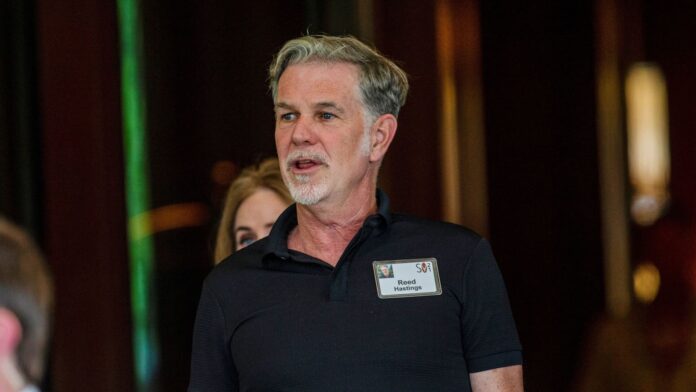Reed Hastings, co-founder, chairman, and co-chief executive officer of Netflix, arrives for the annual Allen and Co. Sun Valley media conference in Sun Valley, Idaho, U.S. July 6, 2021.
Brian Losness | Reuters
Netflix founder and co-CEO Reed Hastings said Wednesday he was slow to come around to advertising on the streaming platform because he was too focused on digital competition from Facebook and Google.
“I didn’t believe in the ad-supported tactic for us. I was wrong about that. Hulu proved you could do that at scale and offer customers lower prices. We did switch on that,” Hastings said at The New York Times’ Dealbook conference. “I wish we had flipped a few years earlier on that, but we’ll catch up.”
Netflix had for years resisted the idea of allowing advertising on its service. But after coming under pressure because of its slowing subscription growth, Hastings said in April that the company was “open” to offering a cheaper option with ads. The offering launched in the U.S. earlier this month for $6.99 per month in partnership with Microsoft.
The reversal came after some convincing from Chief Financial Officer Spencer Neumann, according to Hastings.
“The big thing that I missed is I was on the Facebook board, so I bought in for a decade to the belief that systems relying on data were going to be able to do higher CPMs than anyone else,” Hastings said, referring to a marketing metric used to calculate the cost per advertising impressions. “So Google and Facebook were going to mop up the world — and they have in non-TV advertising.”
“What I failed to understand is that there is a lot of TV advertising that now couldn’t find the viewers because the 18- to 49-[year old] segment had moved on and were not watching linear TV,” he said.
Advertisers were “desperate” for avenues in connected TV and internet, Hastings said, but Netflix was still on the sidelines.
“We didn’t have to steal away the advertising revenue. It was pouring into connected TV. The inventory was there,” he said.
Hulu, Warner Bros. Discovery’s HBO Max, NBCUniversal’s Peacock, Paramount Global’s Paramount+, and others already offer cheaper, ad-supported options. Disney+ plans to launch a cheaper, ad-supported tier, while also raising prices for its commercial-free option and other streaming services.
There are also free streaming services, such as Paramount’s Pluto and Fox Corp.’s Tubi, which make revenue solely through advertising. Recently, Fox said Tubi’s ad revenue, which grew 30% in its most recent quarter, lifted its earnings.
Netflix’s foray into advertising is an effort to lure more subscribers. The streaming service had hiked prices for its subscribers earlier this year, which bolstered revenue but was partly to blame for a loss of 600,000 subscribers in the U.S. and Canada during the first quarter.
Globally, Netflix had about 223 million subscribers as of Sept. 30.
The ad-based partnership with Microsoft, though, isn’t a precursor to a broader takeover, Hastings said Wednesday.
“It’s not normal to do commercial deals with companies you’re trying to acquire. It makes things more complicated, not less. So that was like zero of the motivation,” he said.
Hastings did acknowledge he had eyes for a different acquisition: Wordle, the popular daily word game that’s now a part of The New York Times gaming suite. The game, which gives players six guesses to match a five-letter word, exploded in popularity earlier this year.
“I berated our M&A team that we didn’t buy Wordle,” Hastings said Wednesday.
Disclosure: Comcast’s NBCUniversal is CNBC’s parent company.
— CNBC’s Lillian Rizzo contributed to this report.


